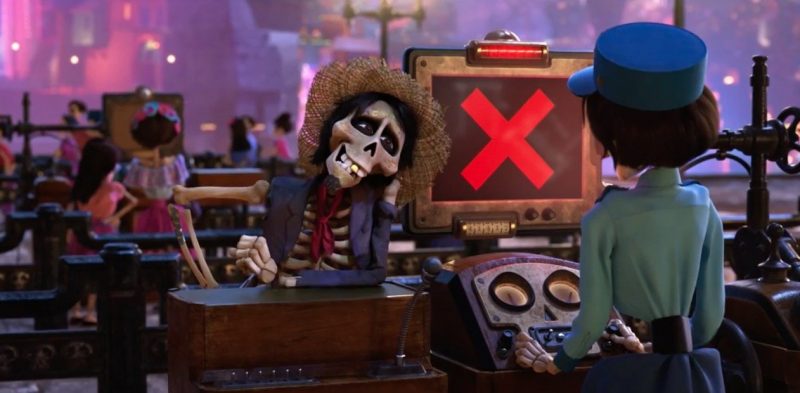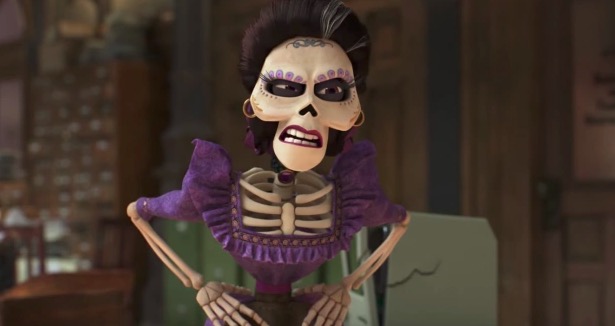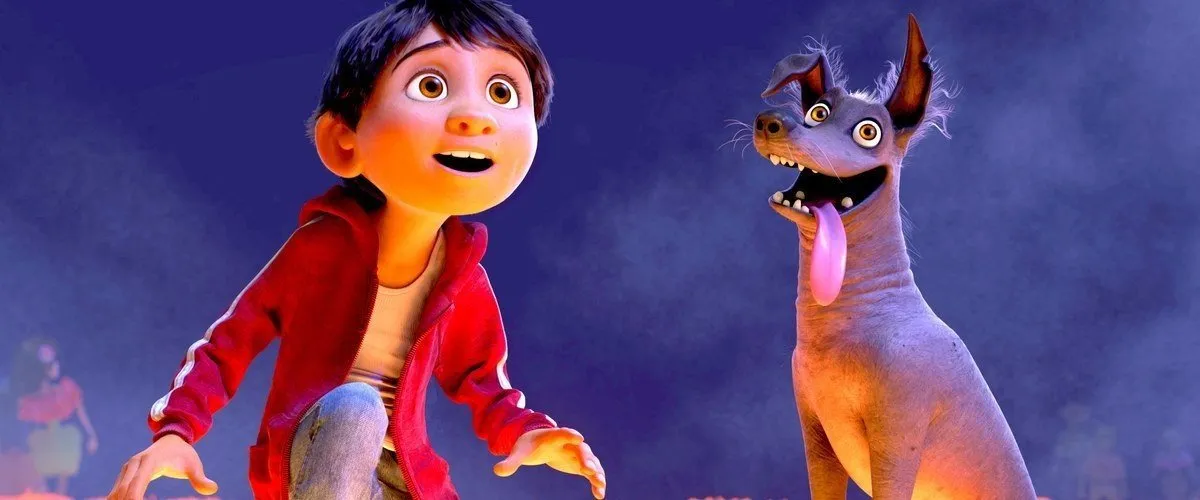As anyone who has ever watched a Disney/Pixar movie, I was ready for some hard punches in the feels, laughs, great new music, and a heartwarming tale of overcoming great odds when I sat down to watch Coco. The recently released Disney/Pixar movie, which topped the US box office for three weeks and has been lauded as much-needed positive representation of Mexican culture and people, centers on Miguel, a young boy who desperately wants to follow in his idol’s (Ernesto De la Cruz) footsteps and become a great musician despite his family’s generations deep hatred for music.
The gambit is that Miguel is transported to the land of the dead, and in order to return to the land of the living, he must secure the blessing of one of his dead relatives. From here, we get themes and tropes that have been explored in many an animated movie: Our young hero runs into opposition from the spirit of his great-great-grandmother, who doesn’t see the value in the hero’s goal; he has a steadfast companion (in this case a Xoloitzcuintli dog named Dante, in a beautiful nod to Aztec belief that these dogs are a person’s faithful companion in our journey between this world and the next); he finds so much more than he expected when he forms an unlikely alliance with Hector, a dead man who simply wants to be remembered by his lost loved ones.
This was a fantastic setup for any original animated feature, but the bonus with Coco was that, with this porterhouse of storytelling, I would also be served a heaping helping of representation of my culture. At long last! Traditions in which my family has partaken for generations would come to life on a huge, international stage, with faces that look like my relatives (well, at least some of them). So, yes, I was fully prepared to cry, but I was not prepared for the reason for my tears. Armed with memories of setting up ofrendas on Dia de Muertos to our family’s departed, I looked forward to a Disneyfied versión of one of my favorite childhood memories. Instead, I found myself reliving one of the worst ones: the time my mom was turned away at the border and my family was separated from her. Watching Hector’s denied entry to the land of the living, and having it played for laughs, is just one of the reasons I left the theater feeling deeply conflicted about Coco.
Of all the ways to present Hector’s inability to cross into the land of the dead to celebrate Dia de Muertos with his family, the writers chose one that hits uncomfortably close to home. It’s an inescapable truth in our world that rules have been designed to keep people on the “right” side of imaginary borders, and that families are kept apart in the name of keeping order. Watching as Hector tries and fails to squeeze by the agents at the end of the cempasúchil bridge, and the recreation of the impersonal, bureaucratic feel of an immigration processing office, had me cringing.

When I was four or five, my dad, sister, and I were able to enter the U.S. for a visit to my dad’s family in New York. My sister and I have had dual citizenship from birth; dad was already a citizen. My mom had her Mexican passport and a tourist visa. She was denied entry into the U.S., and although I don’t remember every detail, I do firmly recall tears, anger, and fear, as we didn’t know when we would see my mother again.
It’s not an event that I think about often, (and that’s privilege for you, that this was resolved in a matter of weeks and that my family and I can think of this event as a footnote rather than a defining moment or an ongoing trauma), but that moment, watching Hector not be allowed to pass through that border check, it awoke that flurry of panic that travels with me as surely as my passport on every international trip. And yes, it tainted my enjoyment of the rest of the movie, with the haunting thought that if I felt this way, having an event so long ago resolved in my past, I didn’t know how families who were more recently have subjected to the whims of a border agent, or who are currently living in a state of legal limbo because of documentation status, might feel watching these scenes. I don’t know if the writers chose this setup to make some kind of commentary about immigration, but the only feeling that I took away was “rules are rules and oh well, what can you do,” which, when I think about this scene even weeks later, has the varying effect of making my blood boil or leaving me thoroughly despondent.
Even before that jarring moment at Mictlan’s Border Patrol, I was sighing with resignation at the lack of variety in the Pixar-depicted Mexican population. I’m not naive enough to have expected a fair representation of what Mexican people can and do look like, but wow it was still surprisingly disappointing to find that Pixar found one shade of brown and really committed to it. Like any colonized land, united under a flag that was imposed by settlers and voyagers on its indigenous inhabitants and the slaves who were brought in to help make it suitable to white needs, there is no one way that a Mexican can look. I always think of the Sandra Cisneros quote from Caramelo:
“There are green-eyed Mexicans. The rich blond Mexicans. The Mexicans with the faces of Arab sheiks. The Jewish Mexicans. The big-footed-as-a-German Mexicans. The leftover-French Mexicans. The chaparrito compact Mexicans. The Tarahumara tall-as-desert-saguaro Mexicans. The Mediterranean Mexicans. The Mexicans with Tunisian eyebrows. The negrito Mexicans of the double coasts. The Chinese Mexicans. The curly-haired, freckled-faced, red-headed Mexicans. The jaguar-lipped Mexicans. The wide-as-a-Tula-tree Zapotec Mexicans. The Lebanese Mexicans. Look, I don’t know what you’re talking about when you say I don’t look Mexican. I am Mexican.”
That lack of physical diversity on-screen is simply an extension of a continued failure of Big Stage Mexican Representation in embracing both our extensive ethnic heritage and our pre-colonial history. We can’t even count on Mexican-made media for this representation. As much as I eagerly await the release of Dia de Muertos by Mexican production company Metacube, I can’t help looking at the stills of the protagonists and short that have been released and thinking, “That’s pretty effing white.” Mexican novelas insist that Mexicans run the range from white-to-kinda tan, and Hollywood assures viewers that Mexicans can look like Salma Hayek, Jaime Camil, or hey, in a pinch, we can look like any other Latinx actor or even an Italian one will do; the narrowly defined “gamut” of physical representation on screen continues its sad, shallow streak in Coco.
In marching past Mexico’s indigenous roots and people, Coco also squandered what I thought was a great opportunity to give viewers some insight on the origins of Dia de Muertos. As it was, we got little more than an allusion to its origins (the aforementioned Dante), which span back to Mesoamerican times, or a hint that Dia de Muertos doesn’t belong solely to any one portion of the Mexican population (indeed, it doesn’t even belong solely to Mexico, either).
There were other things that gave me pause when watching Coco that also deserve some consideration. Do women only get to be “strong” if they’re depicted as scolds? This is as much a question in any form of entertainment as it is specifically for Coco. Imelda, Miguel’s great-great-grandmother, raised her daughter, Coco, on her own. She started the family’s shoemaking business and is presented as a formidable woman, but most of the impressions we get of her are that she is someone to be respected out of fear of earning her disapproval, which Miguel does when he adamantly refuses to renounce his love of music in exchange for Imelda’s blessing.

Or, if a woman’s presence isn’t helping to shape and drive the narrative but you just have to have Frida Kahlo in your Mexican movie, should you pop her in as comic relief (the answer here is yes, I guess)? That felt like an odd decision to me, and it led to many moments of feeling like a traitor for laughing anyway. Yes, Frida was eccentric; yes, many times the subject of her art was herself, but in a movie where Pedro Infante, Jorge Negrete, Maria Felix, Santo, and even Cantinflas got pretty straightforward cameos, why make Frida Kahlo your comic relief? Cantinflas was an actual comic actor! I’m not going to pretend that I will ever look at papaya seeds again and not chuckle, though.
Why, in a Disney/Pixar movie, does it feel like there weren’t enough musical moments? Was it because the music was too “ethnic”? It’s a movie about a boy who wants to be a musician, in which the majority of the characters who can help him return to his living relatives are also musical, yet I left feeling like the movie could have given us more in that regard. And why is it that, even in death, is there a classist hierarchy in which the winners of the Remember Me lottery live in splendor, and the forgotten in squalor? The scene in which we meet Hector’s friend Chicharron made my jaw drop. According to Coco, if your relatives forget you or neglect to honor you properly by placing your photo in their ofrenda, your very spirit ceases to exist. Oh! But not before being forced to live in a dimly lit, neglected part of the land of the dead, where the homes look like they’re a too-harsh breath away from falling on your vanishing bones.
No one piece of art can be all the things, and I want to see my culture represented on my screen more often, so all of these observations leave me feeling like I’m sending back what I think is an undercooked steak and fearing that the chef just won’t cook for my family anymore. Still, Coco is not a depiction that I can support without comment. It’s a good start, but in the future, I would like to see representation that is truly inclusive, and less filtered through a white or white-adjacent lens.
This movie that is a love letter to Mexico left me with the uncomfortable feeling that it was made for a very specific Mexico. It’s one that fits a particular mold and doesn’t mind seeing an afterlife depicted as a more colorful, bony reflection of a current reality. We already live in a world where there are rules that keep people from crossing borders from one stolen land into another. We already live in a world where, if you are not lucky enough to fall into a privileged category where you’re seen as worthy to those who hold the purse strings, you’re living hand-to-mouth. Even in death, according to Coco, families are going to be kept apart at borders, and abject poverty is a likelihood if you’re unlucky enough to be in a class of “forgotten” ones.
Mexico has a long ways to go in making art truly inclusive, and in being fully and inclusively represented in art outside of Mexico. Our real world is one of intersection upon intersection upon intersection, and yet we insist on only giving the biggest stage to the art of people happy to pretend those intersections don’t exist, to the people who make art that is safe for the consumption of the white American standard. And that, to me, was the biggest disappointment in Coco—that the people called upon to make it authentic rooted this authenticity in the same vision of Mexico that is often so vexing: brown, but not too brown. Riches for the worthy. Gates in place to keep the right people on the sides where they belong.
Reading this it must sound like I hate everything about Coco. Even if I, admittedly, had a sour taste in my mouth from Disney’s attempt to trademark Dia De Los Muertos (which, WTF), I don’t hate Coco. In fact, there’s much to love about it. Miguel’s family, with its multi-generational living, pride in a business built by that family’s hard work, and the feeling of love and connectedness among them was something that rings very true when I look at my own family. His struggles to set himself apart are also relatable, because there are few things as agonizing as having to tell your abuela that you are not the person she envisioned you to be.
I was worried that the only music style in the movie would be Mariachi, but the diverse styles in the songs left me breathless with joy. The liberal use of cempasúchil, the retelling of the family’s history via papel picado, and even the threat of remediation by chancla, all had me grinning from ear to ear. I’ll confess, I did not hydrate nearly enough for all the sobby weeping I was in for. So, no, I don’t hate Coco. I don’t even dislike it. But would I recommend it as viewing for people interested in learning about Dia de Muertos or Mexican culture? Probably, but only because it’s not like there’s not much in the way of representation otherwise. I don’t feel pride in being Mexican simply because this aspect of my culture now bears the Disney seal of approval. But as my abuela (and probably every abuela ever) likes to say, “Peor es nada.”
(images: Disney)
Carla Temis is a writer, a fan of TV, film, music, inclusive representation, fanfic, and an occasional participant in fandom squeeing. Find her on Twitter @MexiCarli.
Want more stories like this? Become a subscriber and support the site!
If you purchase something through our links, The Mary Sue may earn an affiliate commission.
—The Mary Sue has a strict comment policy that forbids, but is not limited to, personal insults toward anyone, hate speech, and trolling.—









Published: Dec 22, 2017 10:13 am